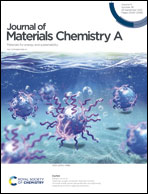Strong anisotropic hydrogels with ion transport capability via reswelling contrast of two oriented polymer networks†
Abstract
Integrating designed structural, mechanical, and ion-transport properties into one soft material system is a fascinating topic for potential applications yet rarely achieved. This study reports the development of anisotropic hydrogels with superior mechanical and ion-transport properties via an orienting-reswelling strategy. The essence of this method is to take advantage of the reswelling disparity of two oriented polymer networks that possess contrasting persistence lengths. The oriented flexible polymer, due to its small persistence length, disorients after reswelling, while the oriented semi-rigid polymer with a large persistence length can preserve the orientation. Such a reswelling contrast leads to the formation of an anisotropic soft–stiff hybridized structure with low tortuosity, which favors the mechanical and ion-transport properties of the resulting hydrogel simultaneously. Considering that there are numerous compatible hydrophilic polymers with contrasting persistence lengths, this study offers a versatile guide towards the design of all-around hydrogels with anisotropy, high strength, and ion-transport capability.



 Please wait while we load your content...
Please wait while we load your content...